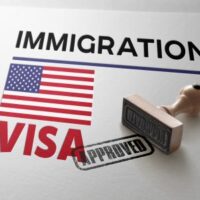All Family Connection Visas That Exist

Family reunification is a cornerstone of U.S. immigration policy, allowing U.S. citizens and lawful permanent residents (LPRs) to bring family members from abroad to live in the United States. Various visa categories, collectively known as family connection visas, facilitate this process. Consult with the Houston immigration law firm of BBA Law Group to explore all the family connection visas available for your individual situation to help you understand each category and its requirements.
Immediate Relative Visas
These visas are for close family relations of U.S. citizens. There’s no annual limit on the number of visas issued in these categories, making them a quicker option for family reunification.
IR-1: Spouse of a U.S. Citizen
This visa allows the spouse of a U.S. citizen to immigrate to the U.S. The couple must prove the legitimacy of their marriage and meet all other immigration requirements.
IR-2: Unmarried Child Under 21 of a U.S. Citizen
U.S. citizens can bring their unmarried children under the age of 21 to the U.S. using this visa category.
IR-3: Orphan Adopted Abroad by a U.S. Citizen
This category is for U.S. citizens who have completed the adoption of a child from another country. The adoption process must meet specific U.S. legal requirements.
IR-4: Orphan to be Adopted in the U.S. by a U.S. Citizen
This visa is for orphans who will be adopted by a U.S. citizen once they arrive in the United States.
IR-5: Parent of a U.S. Citizen who is at least 21 years old
U.S. citizens who are at least 21 years old can sponsor their parents for immigration to the United States.
Family Preference Visas
Unlike immediate relative visas, family preference visas are subject to annual numerical limits. Consequently, there are often longer waiting periods for these visas.
F1: Unmarried Sons and Daughters of U.S. Citizens and their Minor Children
This category allows unmarried adult children (21 years and older) of U.S. citizens to immigrate to the U.S. along with their minor children.
F2: Spouses, Minor Children, and Unmarried Sons and Daughters (21 years and older) of LPRs
– F2A: Spouses and minor children of LPRs.
– F2B: Unmarried adult children of LPRs.
F3: Married Sons and Daughters of U.S. Citizens and their Spouses and Minor Children
U.S. citizens can sponsor their married children, along with their children’s spouses and minor children.
F4: Brothers and Sisters of Adult U.S. Citizens and their Spouses and Minor Children
U.S. citizens who are at least 21 years old can sponsor their siblings, along with their siblings’ spouses and minor children.
K Visas: Fiancé(e)s and Spouses of U.S. Citizens
K visas are for the fiancé(e)s and spouses of U.S. citizens, allowing them to travel to the U.S. for marriage and subsequent residency.
K-1: Fiancé(e) Visa
The K-1 visa permits a foreign national fiancé(e) of a U.S. citizen to travel to the United States to marry within 90 days of arrival. After the marriage, the foreign national can apply for adjustment of status to a permanent resident (LPR).
K-2: Minor Child of K-1 Visa Holder
Children of K-1 visa holders can accompany their parent to the U.S. under the K-2 visa category.
K-3: Spouse of a U.S. Citizen Awaiting Availability of an Immigrant Visa
The K-3 visa allows the foreign-citizen spouse of a U.S. citizen to enter the U.S. while they are waiting for the immigrant visa petition to be approved.
K-4: Minor Child of K-3 Visa Holder
Children of K-3 visa holders can accompany their parent to the U.S. under the K-4 visa category.
V Visa: Spouses and Children of Lawful Permanent Residents
The V visa category is for the spouses and minor children of LPRs. It allows families to stay together in the U.S. while waiting for the processing of immigrant visas.
Applying for Family Connection Visas
The application process for family connection visas typically involves:
- Filing a Petition: The U.S. citizen or LPR sponsor must file a petition with U.S. Citizenship and Immigration Services (USCIS). For immediate relatives and family preference visas, this is Form I-130. For fiancé(e) visas, it’s Form I-129F.
- Visa Application: Once the petition is approved, the family member abroad must apply for the visa at a U.S. embassy or consulate.
- Interview and Approval: The applicant will undergo an interview at the embassy or consulate. If approved, they can travel to the U.S.
- Adjustment of Status: In some cases, after arriving in the U.S., the individual can apply for adjustment of status to become a lawful permanent resident.
Contact BBA Law Group
Family connection visas offer a range of options for reuniting families in the United States. Each category has specific requirements and processes, making it essential to understand the best fit for your family’s situation.
If you’re considering applying for a family connection visa, BBA Law Group can provide expert guidance and support throughout the process. Our experienced immigration attorneys understand the nuances of family-based immigration and are dedicated to helping families come together in the United States. Contact us today to start your journey.
Source:
uscis.gov/green-card/green-card-eligibility/green-card-for-family-preference-immigrants
